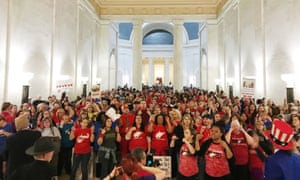Old-fashioned, union protest works. This is democracy in action.
Taking to the streets, picketing on the sidewalks, and charging into the Capitol itself, the strike turned the public commons into a counter space for “we the people.”
Thanks to Dr. Tony Baez for sharing.
-Angela
The West Virginia teacher's strike is what real resistance looks like
This kind of resistance does not allow onlookers to look away, especially in an age of social media. It brings the story to those who have refused to read it
Taking to the streets, picketing on the sidewalks, and charging into the Capitol itself, the strike turned the public commons into a counter space for “we the people.”
One by one, the roughly 20,000 teachers in West Virginia essentially forced lawmakers – and the nation – to stop our daily routine and address the growing education crisis on the terms of those most devoted to ensuring the best outcomes for our children: our teachers.
This is why strikes, more than one-day protests, often bring lasting victories. It took an uncompromising walk-out to get West Virginia lawmakers to recognize that our inability to commit to a living wage and decent health benefits for our teachers mirrors our negligence in investing in classrooms for our children.
Instead of a fleeting protest, the hardship of the open-ended West Virginia strike reflected the urgency of our times and the long-haul commitment of the teachers for an enduring resolution, not a compromise or some sort of fleeting gain.
With an estimated 10% of the American workforce reportedly in a union, the legacy of striking might have become a lost tactic to some. As the son of a union teacher and the grandson of a union coal miner, I believe the West Virginia teachers have renewed a strategic call for other movements engaged in what we have called a “resistance” against the onslaught of policies decisions and regulatory rollbacks by the Trump administration.
The time has come to employ strikes in other areas.
When it comes to dealing with the inexorable grip of the National Rifle Association lobby on our gun policies or the undue influence of the oil, gas and coal lobbies on our energy and climate plans, for example, wide-scale strikes by students, teachers and all concerned citizens may be our last best hope for policy changes today.
Imagine how quickly we could begin to deal with gun control, if all pre-school employees, teachers and staff walked out and went on an indefinite strike – and the large majority of supporters, according to most polls, joined them.
Imagine how swiftly we could start the process of transitioning to renewable energy alternatives, low-carbon transportation designs, local food and regenerative agricultural policies, if all school employees, teachers and students refused to teach and study in schools powered by carbon emission-spewing fossil fuels that are destabilizing our planet.
The strike in West Virginia has powerfully revived this historic tactic for the rest of the nation.
Addressing the same egregious combination of low wages and underfunded schools in bottom-rung states like Arizona and Oklahoma, teachers are wearing red in solidarity this week and negotiating the terms of their own possible walk-outs to raise attention to the instability of school districts that have been gutted by disastrous funding policies.
This is a tactical lesson of resistance that reminds us that our schools have always served as the front lines of the challenges of inequality facing our communities.
This kind of resistance does not allow onlookers to look away, especially in an age of social media. It brings the story to those who have refused to read it. It forces everyone to take part in the national discussion, and engage in the still small possibility of justice.
Jeff Biggers is the author of the forthcoming book, Resistance: Reclaiming an American Tradition
Imagine how swiftly we could start the process of transitioning to renewable energy alternatives, low-carbon transportation designs, local food and regenerative agricultural policies, if all school employees, teachers and students refused to teach and study in schools powered by carbon emission-spewing fossil fuels that are destabilizing our planet.
The strike in West Virginia has powerfully revived this historic tactic for the rest of the nation.
Addressing the same egregious combination of low wages and underfunded schools in bottom-rung states like Arizona and Oklahoma, teachers are wearing red in solidarity this week and negotiating the terms of their own possible walk-outs to raise attention to the instability of school districts that have been gutted by disastrous funding policies.
This is a tactical lesson of resistance that reminds us that our schools have always served as the front lines of the challenges of inequality facing our communities.
This kind of resistance does not allow onlookers to look away, especially in an age of social media. It brings the story to those who have refused to read it. It forces everyone to take part in the national discussion, and engage in the still small possibility of justice.
Jeff Biggers is the author of the forthcoming book, Resistance: Reclaiming an American Tradition

No comments:
Post a Comment